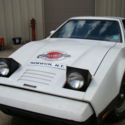1974 Moskvich 412
- Price:
- Location: Bucharest, default, Romania
- Make: Other Makes
- Trim: Sedan 4 doors
- Year: 1974
- Mileage: 16,000
- VIN: 240244
- Engine size: 1360 cmc
- Number of cylinders: 4
- Fuel: Gasoline
- Transmission: Manual
- Drive type: RWD
- Vehicle Title: Clear
1974 Other Makes Sedan 4 doors Description
1974 MOSKVICH 412VERY GOOD CONDITION, VERY HARD TO FIND SIMILAR,SUITABLE FOR MUSEUM OR PARTICULAR COLLECTIONS.THE SELLER TAKES THE RESPONSABILITY FOR SHIPPING. I WILL HELP AND ASSIST WITH LOADING.ENGINE NOT STARTED FROM 6 YEARS!
THE CAR IS REGISTERED WITH ALL DOCUMENTS
The Moskvitch 412 (Moskvich 412, Москвич 412, M-412) was a small family car produced by Soviet/Russian manufacturer MZMA/AZLK in Moscow from 1967 to 1975, and by IZh in Izhevsk from 1967 to 1982 (also known as Izh-412). It was a more powerful and prestigious version of the M-408 model, offering more features to the driver for a higher price.
The Moskvitch 412 was a derivate of Moskvitch 408, differing in more powerful 1.5 engine. The earliest engines for the M-412 were built in 1964.The Moskvitch-412 had a slanted (to a tilt of 20 degrees) inline-four engine with a block, head, and inlet manifold cast in aluminium alloy in order not to increase the weight of the engine and a hemispherical combustion chamber. Steel cylinder liners were replaceable to enable easy repair of the engine instead of having to replace it entirely. Since it was of an OHC design it was taller than the OHV MZMA-408 engine it replaced, which is why it was mounted at a slant. The UZAM-412 had a capacity of 1,478cc (90.2cuin) c.c. and developed 75 horsepowers. Its more powerful version, the Moskvitch-412-2V, had 100 h.p. and was installed on sports cars. The 1,478cc (90.2cuin) UZAM-412 engine, with a light alloy block, was designed by Igor I. Okunev. According to some observers, it bore some similarities to the contemporary BMW M 115 motor used in the BMW 1500 model, although in other ways they are different from each other. The gearbox inherited from the M-408 was improved, with the gearbox ratios being revised to make better use of the increased power output.
In 1969, both the M-412 and the related M-408 had their body redesigned. These were notable for being the first Moskvitch models to feature rectangular headlights and horizontal rear lights, which passed on to the 2138/2140 in 1976, replacing round headlights (two on ordinary models, four mainly on export models) and vertical rear lights. Only rear triangular turn signals remained on vestigial tailfins. Until then, the M-412 profited from heightened tailfins and tanned headlight lamps on export models. Another notable (but not unique, as it was used in other Russian cars at the time) feature were the so-called side signals, mounted on the C-pillars on some vehicles and similar to the American "opera lights". The car was upgraded with dual-circuit brake system, reinforced car-body structure, and passive safety features such as soft grip steering wheel cover, soft interior parts, seat belts, and padded dashboard. It was the first Moskvitch to pass safety features tests in France, Bulgaria, Czechoslovakia, and Sweden in 1970—71, and in Western Germany in 1972. The modernized model, both for export and domestic market, received a factory code M-412IE (IE for "export rendition"), to mark, that it fulfils new safety requirements.
The M-412 was launched in the United Kingdom in 1969, when the first 20 dealerships were set up and some 300 cars were sold; its sales increased annually and peaked in 1973, when some 14,500 cars were exported through a 268-dealer network. However, soon afterwards they was pushed off the British market by the fellow Soviet brand Lada, down to only 3462 sales in 1973 and 344 in 1975, so that Moskvitch decided to withdraw from the United Kingdom.
SATRA's 1974 rebranding it the Moskvitch 1500 did not change anything.
1975 Moskvitch 412IE (Elite)SATRA Motors entered M-412s in the Group One Production Saloon Car Championship in 1972 and 1973, where it easily beat "sharp-handling but underpowered" Hillman Imps and Austin Minis. It also placed 1-2-3 in the 1973 Avon Round Britain Rally and scored a class win in the South Africa Safari Rally the same year
 1974 Moskvich 408
1974 Moskvich 408
Mileage: 16,000
 1974 bricklin
1974 bricklin
 1974 BRICKLIN SV1
1974 BRICKLIN SV1
Mileage: 23,103
 1974 Albany
1974 Albany
Mileage: 12,000
 1974 Bricklin SV-1
1974 Bricklin SV-1
Mileage: 64,662
 1974 TVR 2500M
1974 TVR 2500M
Mileage: 44,460
 1974 custom bricklin
1974 custom bricklin
Mileage: 79,000
 1974 Pinzgauer 710M
1974 Pinzgauer 710M
Mileage: 8,600
 1974 Stutz Blackhawk
1974 Stutz Blackhawk
Mileage: 60,001
 1974 Jensen Interceptor Mk. III
1974 Jensen Interceptor Mk. III
Mileage: 41,284









